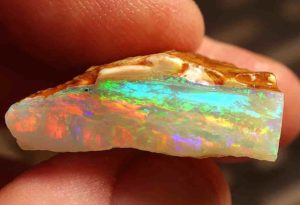
Fire Opal
Fire opal is a translucent opal with warm body colors ranging from yellow to orange to gold. Even though it usually doesn’t show any color play, sometimes a stone will show bright green flashes. Querétaro in Mexico is the most popular supplier of fire opals; these opals are commonly referred to as Mexican fire opals.
Sometimes fire opals that do not display color play are referred to as jelly opals. Occasionally Mexican opals are cut into their rhyolitic host material if slicing and polishing is difficult enough. A form of opal from Mexico is called an opal from Cantera. A type of opal from Mexico, known as Mexican water opal, is also a colorless opal that shows either a bluish or golden internal shine.
Not all fire opals are similar. We distinguish between the common fire opals, which are either faced or cut into cabochons depending on their quality, and the particularly valuable ones, which, in addition to their vivacious color, also have the typical opal gaudy color play. But the fire opal plays its part as a high-quality gemstone to perfection with or without color play.
Fire opal has a Mohs hardness of 5.5 to 6, which is weak enough that many items will damage it during daily wear. Fire opal is also poor in tenacity, meaning it can be chipped or broken quickly.
Fire opal is best used in accessories such as earrings, pins and pendants that are not normally exposed to rough wear. If a fire opal is placed into a circle, it is recommended to have a setting built specifically to protect the stone from abrasion and impact.
How Is Fire Opal Formed?
Opal is a hydrated amorphous type of silica (SiO2·nH2O); its water content can differ by weight from 3 to 21%, but is typically between 6 and 10%. It is known as a mineraloid because of its amorphous nature, unlike crystalline types of silica, classified as minerals. It is deposited at a relatively low temperature and can occur in nearly any rock fissures, most commonly found in limonite, sandstone, rhyolite, marl, and basalt. Opal is Australia’s largest gemstone.
There are two broad opal classes: precious and normal. Play-of-color (iridescence) precious opal shows, not regular opal. Play-of-color was described as’ a pseudochromatic optical effect resulting in bursts of colored light from certain minerals as they are converted into white light.’ The precious opal’s internal structure allows it to diffract light, resulting in play-of-colour. Opal may be clear, translucent or opaque depending on the conditions under which it was made, and the background color may be white, black or almost any color of the visual spectrum.
Where Is Fire Opal Found?
For nearly 100 years, Mexico has been the primary fire opal source in the world. Fire Opal is found in Queretaro, Hidalgo, Guerrero, Michoacan, Julisio, Chihuahua and San Luis Potosi states of Mexico. Queretaro’s mines are the most important and have been mining since 1835. Small fire opal pebbles can be found in silica-rich lava flows.
Smaller quantities of fire opal are produced in Australia, Brazil, Honduras and Guatemala. Some beautiful fire opals are produced in the United States, Nevada and Oregon.
Is Fire Opal valuable?
Fire opal is a mineral opal variety, red, orange or yellow in colour. The visibility and clarity differ, as well as the particular complexity and brightness of its color, and these are some of the factors that determine the quality of fire opal. In comparison, the price of red fire opal is usually higher than the price of yellow samples.
Why is opal so expensive?
Several experienced opal valuers will price the opal per carat and the final value will be determined by the average price per carat. Over many years there has been guidelines developed on how to value Opal. We are going to explore the some factors that contribute to an Opals final value.
COLOR : Color is the first thing that you will notice about an opal. Red is the rarest and most sought out color. In order of value, the most valuable color is red, then orange, green, blue and purple. However, Opal is usually never a single color.
DIRECTION OF COLOR : Opals are a gemstone that dramatically change appearance based on what angle the Opal is viewed at. When an Opal is at it’s brightest, this is called ‘facing’. The direction of color can affect the price becuase it will determine how versatile the Opal is.
PATTERN : Opals that have a rare or unique pattern are more valuable. The Harlequin pattern is the rarest and most loved pattern in opals but it is very rare.
BRIGHTNESS : The Opal brightness guide was produced by the Australian opal association along with the body tone guide.










